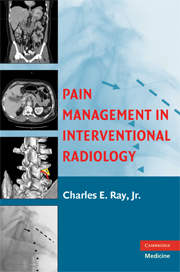Book contents
- Frontmatter
- Contents
- Contributors
- Preface
- Acknowledgments
- 1 Pain Management in Interventional Radiology: An Introduction
- 2 Clinical Evaluation of Low-Back Pain
- PART I LOCOREGIONAL PAIN CONTROL
- 3 Local Anesthetics
- 4 Functional Lumbar Spine Anatomy: A Review
- 5 Percutaneous Vertebroplasty
- 6 Kyphoplasty
- 7 Epidural Steroid Injections
- 8 Selective Nerve Root Blocks
- 9 Discography
- 10 Facet (Zygapophyseal) Joint Injections
- 11 Articular Interventions in Pain Management: A General Approach
- 12 Percutaneous Management of Visceral Pain
- 13 Embolization of Painful Neoplasms
- 14 Image-Guided Ablation of Painful Osteolyses
- 15 Chronic Pelvic Pain in Women
- PART II SYSTEMIC PAIN CONTROL
- Index
- References
15 - Chronic Pelvic Pain in Women
from PART I - LOCOREGIONAL PAIN CONTROL
Published online by Cambridge University Press: 04 September 2009
- Frontmatter
- Contents
- Contributors
- Preface
- Acknowledgments
- 1 Pain Management in Interventional Radiology: An Introduction
- 2 Clinical Evaluation of Low-Back Pain
- PART I LOCOREGIONAL PAIN CONTROL
- 3 Local Anesthetics
- 4 Functional Lumbar Spine Anatomy: A Review
- 5 Percutaneous Vertebroplasty
- 6 Kyphoplasty
- 7 Epidural Steroid Injections
- 8 Selective Nerve Root Blocks
- 9 Discography
- 10 Facet (Zygapophyseal) Joint Injections
- 11 Articular Interventions in Pain Management: A General Approach
- 12 Percutaneous Management of Visceral Pain
- 13 Embolization of Painful Neoplasms
- 14 Image-Guided Ablation of Painful Osteolyses
- 15 Chronic Pelvic Pain in Women
- PART II SYSTEMIC PAIN CONTROL
- Index
- References
Summary
Chronic pelvic pain (CPP) can be defined as nonmenstrual pain of three or more months' duration that localizes to the anatomic pelvis and is severe enough to cause functional disability and require medical or surgical treatment (1). Chronic dysmenorrhea or menstrual pain of six or more months' duration that causes functional disability and requires medical or surgical treatment is also appropriately included in the definition. This condition can have a strong influence on the patient's quality of life, being associated with years of disability and suffering, loss of employment, and marital discord. In treating CPP, the primary aim is to improve the quality of life (Table 1) (2,3).
EPIDEMIOLOGY
CPP in women is a common gynecological problem with an estimated prevalence of 38 per 1,000 women (3.8%), which is higher than that of migraine headaches (2.1%) and is similar to that of asthma (3.7%) or back pain (4.1%) (4). Women with pelvic pain account for up to 40% of patients attending gynecological outpatient clinics and is estimated to occur in 15% of all women between the ages of 18 and 50 years (5). Such patients use three times more medication, have four times more nongynecological operations, and are five times more likely to have hysterectomy (6). In fact, 15% of all hysterectomies and 35% of diagnostic laparoscopies are performed because of chronic pelvic pain (1), and it is estimated that $881.5 million dollars are spent each year on its outpatient management in the United States (4).
- Type
- Chapter
- Information
- Pain Management in Interventional Radiology , pp. 232 - 238Publisher: Cambridge University PressPrint publication year: 2008



